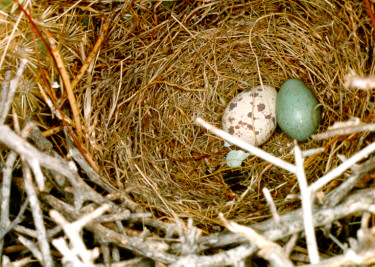Additional Curve-bill Thrasher Photos and Topics
Photo by Greg Clark, April 1998
 At left is a typical Curve-bill Thrasher stick nest, lined with grass, containing three eggs of normal color, size, and shape. The eggs of the Curve-bill are pale green in color and are uniformly covered with very small reddish-brown spots. In poor light, or when viewed in the mirror of a mirror-pole, the spots can be very hard to see. The Crissal Thrasher is the only Thrasher with "robin's egg blue" eggs that has no spots at all. Both birds nest in the same locales but the Crissal prefers trees over cactus and the nests are usually higher up in the tree. Curve-bill nests are usually 1.5 meters to 2 meters above ground, and nearly always in cholla. The Bendire's Thrasher (see our web page for photo) does not have eggs that can be confused with the Curve-bill or Crissal Thrasher. However, Bendire's will nest in cholla and so it is wise to look at the nest closely to see if the nest is structurally different. Bendire's nests are usually smaller overall and the sticks are smaller in diameter. This can help with an identification of "used-nest" when the eggs are not present.
At left is a typical Curve-bill Thrasher stick nest, lined with grass, containing three eggs of normal color, size, and shape. The eggs of the Curve-bill are pale green in color and are uniformly covered with very small reddish-brown spots. In poor light, or when viewed in the mirror of a mirror-pole, the spots can be very hard to see. The Crissal Thrasher is the only Thrasher with "robin's egg blue" eggs that has no spots at all. Both birds nest in the same locales but the Crissal prefers trees over cactus and the nests are usually higher up in the tree. Curve-bill nests are usually 1.5 meters to 2 meters above ground, and nearly always in cholla. The Bendire's Thrasher (see our web page for photo) does not have eggs that can be confused with the Curve-bill or Crissal Thrasher. However, Bendire's will nest in cholla and so it is wise to look at the nest closely to see if the nest is structurally different. Bendire's nests are usually smaller overall and the sticks are smaller in diameter. This can help with an identification of "used-nest" when the eggs are not present.
Nest With What?
Photo by Greg Clark, April, 1998

So far you have read about Curve-bill nests with no eggs and the snakes that eat them, typical Curve-bill nests and what the eggs look like, and a little bit about how to tell Curve-bill, Crissal, and Bendire's Thrasher nests and eggs apart from each other. Now YOU are in the field, and you come upon this. By now you have figured out what kind of nest it is, and you are pretty sure you can go to the bank on the green-colored egg, but as for the white egg with brown spots you have no clue. One of the great joys of atlasing is being confronted with a puzzle like this. Back to basics here. 1. What is the shape of the egg? 2. You know what the green egg is, so you know what laid it. What is the size of the white egg? How can relative size of eggs help you with the ID of the bird? 3. Are there bird parasites that lay eggs that look like this, and what ARE the birds that lay white eggs with brown spots? Try to figure it out before going to the next page.
More information about this topic
Copyright Greg Clark, 1998
update 8/2012
 At left is a typical Curve-bill Thrasher stick nest, lined with grass, containing three eggs of normal color, size, and shape. The eggs of the Curve-bill are pale green in color and are uniformly covered with very small reddish-brown spots. In poor light, or when viewed in the mirror of a mirror-pole, the spots can be very hard to see. The Crissal Thrasher is the only Thrasher with "robin's egg blue" eggs that has no spots at all. Both birds nest in the same locales but the Crissal prefers trees over cactus and the nests are usually higher up in the tree. Curve-bill nests are usually 1.5 meters to 2 meters above ground, and nearly always in cholla. The Bendire's Thrasher (see our web page for photo) does not have eggs that can be confused with the Curve-bill or Crissal Thrasher. However, Bendire's will nest in cholla and so it is wise to look at the nest closely to see if the nest is structurally different. Bendire's nests are usually smaller overall and the sticks are smaller in diameter. This can help with an identification of "used-nest" when the eggs are not present.
At left is a typical Curve-bill Thrasher stick nest, lined with grass, containing three eggs of normal color, size, and shape. The eggs of the Curve-bill are pale green in color and are uniformly covered with very small reddish-brown spots. In poor light, or when viewed in the mirror of a mirror-pole, the spots can be very hard to see. The Crissal Thrasher is the only Thrasher with "robin's egg blue" eggs that has no spots at all. Both birds nest in the same locales but the Crissal prefers trees over cactus and the nests are usually higher up in the tree. Curve-bill nests are usually 1.5 meters to 2 meters above ground, and nearly always in cholla. The Bendire's Thrasher (see our web page for photo) does not have eggs that can be confused with the Curve-bill or Crissal Thrasher. However, Bendire's will nest in cholla and so it is wise to look at the nest closely to see if the nest is structurally different. Bendire's nests are usually smaller overall and the sticks are smaller in diameter. This can help with an identification of "used-nest" when the eggs are not present.